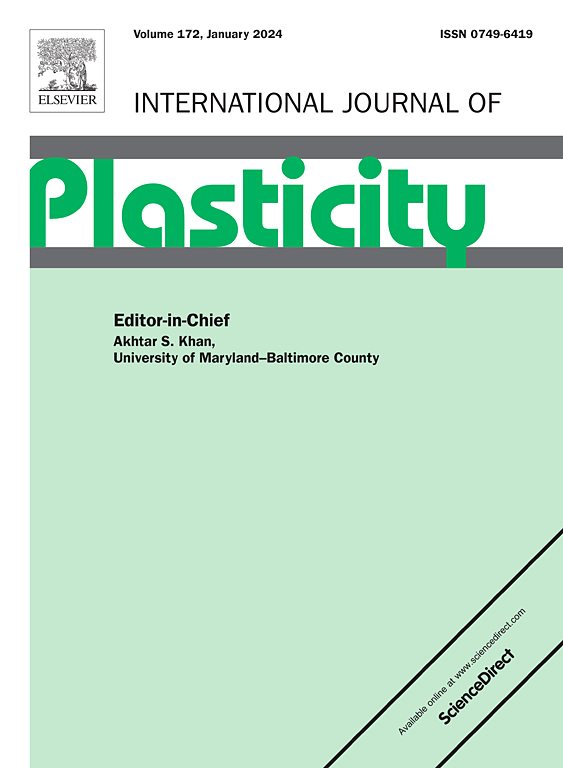Bayesian inference and GPSR-based void nucleation probability model for polycrystalline Al alloys for spall prediction
IF 12.8
1区 材料科学
Q1 ENGINEERING, MECHANICAL
引用次数: 0
Abstract
Spallation is a mechanism of dynamic fracture in materials that occurs when a compressive shock reflects from a free surface as a tensile wave, causing nucleation and growth of spall voids. Predicting the conditions under which spall voids nucleate is an important aspect of designing materials to resist spall failure. This paper describes a computational approach involving porous crystal plasticity modeling and Bayesian inference to predict void nucleation in polycrystalline metals, which can lead to spall. The model has three basic components. The first is a unified porous crystal plasticity finite element model (CPFEM) that (i) covers a wide range of strain rates by incorporating thermally-activated and drag-dominated glide of dislocations causing slip, and (ii) predicts porosity evolution in image-based micromechanical simulations. The second component involves a concurrent model that embeds a 3D statistically-equivalent representative volume element (SERVE) modeled by the crystal plasticity FEM in an exterior domain modeled by continuum plasticity, to handle spurious effects associated with the impact boundary conditions. The third component is a probabilistic model for void nucleation under dynamic loading, utilizing Bayesian inference and genetic programming symbolic regression (GPSR), where nucleation is assumed to be a limiting state of the void evolution process, corresponding to a near-zero initial void volume fraction with a positive void growth rate. The paper illustrates the use of this model by predicting the conditions for void nucleation in a polycrystalline aluminum alloy 7085-T711 under dynamic loading conditions. By accounting for complex phenomena like stress wave propagation, drag effects on plastic slip rates, and void nucleation and growth, the methodology developed in this work provides a powerful tool for determining void nucleation evolution in polycrystalline metals under dynamic loading conditions leading to spallation.
基于贝叶斯推理和gpsr的多晶铝合金空穴成核概率模型
剥落是材料动态断裂的一种机制,当压缩冲击以拉伸波的形式从自由表面反射回来,导致剥落空洞的成核和生长。预测颗粒空洞成核的条件是设计抗颗粒破坏材料的一个重要方面。本文描述了一种利用多孔晶体塑性建模和贝叶斯推理来预测多晶金属中可能导致剥落的空洞成核的计算方法。该模型有三个基本组成部分。第一个是统一的多孔晶体塑性有限元模型(CPFEM),该模型(i)通过纳入引起滑移的位错的热激活和拖曳主导滑动,涵盖了大范围的应变速率,以及(ii)在基于图像的微力学模拟中预测孔隙度演变。第二个组件涉及一个并行模型,该模型将由晶体塑性有限元模型建模的三维统计等效代表体积单元(SERVE)嵌入到由连续体塑性模型建模的外部域中,以处理与冲击边界条件相关的伪效应。第三部分是基于贝叶斯推理和遗传规划符号回归(GPSR)的动态载荷下孔隙成核概率模型,其中假设成核是孔隙演化过程的极限状态,对应于接近零的初始空隙体积分数和正的空隙生长速率。通过对7085-T711多晶铝合金在动态加载条件下空穴成核条件的预测,说明了该模型的应用。通过考虑诸如应力波传播、阻力对塑性滑移率的影响以及空洞成核和生长等复杂现象,本研究开发的方法为确定多晶金属在动态加载条件下导致散裂的空洞成核演变提供了有力的工具。
本文章由计算机程序翻译,如有差异,请以英文原文为准。
求助全文
约1分钟内获得全文
求助全文
来源期刊

International Journal of Plasticity
工程技术-材料科学:综合
CiteScore
15.30
自引率
26.50%
发文量
256
审稿时长
46 days
期刊介绍:
International Journal of Plasticity aims to present original research encompassing all facets of plastic deformation, damage, and fracture behavior in both isotropic and anisotropic solids. This includes exploring the thermodynamics of plasticity and fracture, continuum theory, and macroscopic as well as microscopic phenomena.
Topics of interest span the plastic behavior of single crystals and polycrystalline metals, ceramics, rocks, soils, composites, nanocrystalline and microelectronics materials, shape memory alloys, ferroelectric ceramics, thin films, and polymers. Additionally, the journal covers plasticity aspects of failure and fracture mechanics. Contributions involving significant experimental, numerical, or theoretical advancements that enhance the understanding of the plastic behavior of solids are particularly valued. Papers addressing the modeling of finite nonlinear elastic deformation, bearing similarities to the modeling of plastic deformation, are also welcomed.
 求助内容:
求助内容: 应助结果提醒方式:
应助结果提醒方式:


